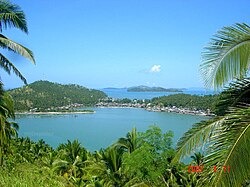Tarangnan | |
|---|---|
| Municipality of Tarangnan | |
 Mountain-top view of Tarangnan | |
 Map of Samar with Tarangnan highlighted | |
Location within the Philippines | |
| Coordinates: 11°54′N124°45′E / 11.9°N 124.75°E | |
| Country | Philippines |
| Region | Eastern Visayas |
| Province | Samar |
| District | 1st district |
| Founded | April 1, 1884 |
| Barangays | 41 (see Barangays) |
| Government | |
| • Type | Sangguniang Bayan |
| • Mayor | Danilo V. Tan |
| • Vice Mayor | Arnel R. Tan |
| • Representative | Stephen James Tan |
| • Electorate | 21,871 voters (2025) |
| Area | |
• Total | 132.49 km2 (51.15 sq mi) |
| Elevation | 16 m (52 ft) |
| Highest elevation | 335 m (1,099 ft) |
| Lowest elevation | 0 m (0 ft) |
| Population (2024 census) [3] | |
• Total | 26,013 |
| • Density | 200/km2 (510/sq mi) |
| • Households | 5,936 |
| Economy | |
| • Income class | 4th municipal income class |
| • Poverty incidence | 33.54 |
| • Revenue | ₱ 165.3 million (2022) |
| • Assets | ₱ 324.3 million (2022) |
| • Expenditure | ₱ 138.3 million (2022) |
| • Liabilities | ₱ 37.29 million (2022) |
| Service provider | |
| • Electricity | Samar 1 Electric Cooperative (SAMELCO 1) |
| Time zone | UTC+8 (PST) |
| ZIP code | 6704 |
| PSGC | |
| IDD : area code | +63 (0)55 |
| Native languages | Waray Tagalog |
Tarangnan, officially the Municipality of Tarangnan (Waray : Bungto han Tarangnan; Tagalog : Bayan ng Tarangnan), is a municipality in the province of Samar, Philippines. According to the 2020 census, it has a population of 25,713 people. [5]
Contents
Tarangnan is situated on the western coast of Samar Island, to the south-east of the ancient town of Bangahon (now Gandara) and to the north of Samar's capital Catbalogan. Tarangnan is found near the former ancient puebloTinago, the first town to be Christianized and was made a center or cabecera. [6]
Tarangnan has its own municipal hospital which was inaugurated in 1982, with a 10-bed capacity. It is augmented by Rural Health Unit extension workers. It has daycare centers which also cater the needs of pre-schoolers.










